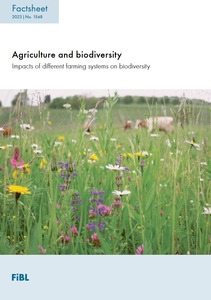{Tool} Organic agriculture and biodiversity. [Landwirtschaft und Biodiversität.] Creator(s): Pfiffner, Lukas and Stöckli, Sibylle. Issuing Organisation(s): FiBL - Research Institute of Organic Agriculture. (2023)
![[thumbnail of 2024-07-31 17_24_08-Agriculture and biodiversity - 1548-biodiversity.pdf – Mozilla Firefox.png]](/53660/1.hassmallThumbnailVersion/2024-07-31%2017_24_08-Agriculture%20and%20biodiversity%20-%201548-biodiversity.pdf%20%E2%80%93%20Mozilla%20Firefox.png)  Preview |
Image (PNG)
- Cover Image
- English
944kB |
|
PDF
- Published Version
- English
2MB | |
|
PDF
- Published Version
- German/Deutsch
3MB | |
|
PDF
- Published Version
- French/Francais
3MB | |
|
PDF
- Published Version
- Polish/Polski
2MB |
Document available online at: https://www.fibl.org/de/shop/1548-biodiversity
Summary
The factsheet summarises the current state of scientific knowledge about the effects of various production and cultivation systems on biological diversity in farmed landscapes. It devotes particular attention to the biodiversity services rendered by organic farming and to the manifold benefits for agriculture derived from the promotion of biodiversity.
Summary translation
Biodiversität gehört zum System des biologischen Landbaus. Die Förderung der Artenvielfalt auf den landwirtschaftlichen Betrieben bildet einen wichtigen Bestandteil der biologischen Produktion. Mit Biodiversitätsflächen, Flächen mit geringer Anbauintensität und einer standortangepassten Bewirtschaftungsweise bieten Biobetriebe mehr Raum und Ressourcen für die unterschiedlichsten Bedürfnisse zahlreicher Arten. Verstärkte Ökosystemdienstleistungen durch grössere Biodiversität dienen den Landwirt*innen, indem sie Eingriffe (z. B. den Einsatz von Insektiziden) in ihr Anbausystem reduzieren können. Funktionelle Gruppen wie Bestäuber, Nützlinge oder Zersetzer werden durch den biologischen Anbau begünstigt. Die Artenvielfalt variiert zwischen den Anbausystemen (u. a. biologisch, konventionell) unterschiedlich stark. Die Unterschiede können aber im direkten Vergleich der Produktionssysteme ebenfalls gross sein: 1-jährige Ackerkulturen, Wein- und Obstbaukulturen oder Dauergrünland haben unterschiedliche Potenziale für die Förderung der Artenvielfalt. Der biologische Anbau fördert mit einer rei- chen biologischen Vielfalt die Stabilität und Resilienz der Produktionssysteme, was bei zunehmend häufiger auftretenden Störereignissen und klimatischen Veränderungen an Bedeutung gewinnt. In Kombination mit Massnahmen des Naturschutzes kann der Biolandbau zusätzliche Synergien zur Förderung der Biodiversität nutzen.
| EPrint Type: | Practice tool |
|---|---|
| Teaser: | Impacts of different farming systems on biodiversity. |
| What problem does the tool address?: | Biodiversity is part of the organic farming systems, as promotion of species diversity on farms is integral to organic production. |
| What solution does the tool offer?: | Via practices such as dedicated biodiversity areas, extensively farmed areas and site-adapted management, organic farms provide more space and resources for the diverse needs of a multitude of species. Farmers benefit from the enhanced ecosystem services provided by greater biodiversity, as this enables them to reduce interventions (e.g. the use of insecticides) in their cropping systems. Functional groups such as pollinators, beneficial insects and decomposers also benefit from organic farming methods. Species diversity varies between farming systems (organic, conventional, etc.). However, there can also be significant differences between farming types within the same system: for example, annual arable crops, viticulture and orchards or permanent grassland offer different potential for promoting species diversity. With increased biodiversity, organic farming promotes stability and resilience in production systems, which is becoming increasingly important as disturbance events become more frequent and climatic changes more pronounced. In combination with nature conservation measures, organic agriculture can leverage additional synergies to promote biodiversity. |
| Country: | Switzerland |
| Type of Practice Tool: | Leaflets & guidelines |
| Keywords: | biodiversity, biodiversity conservation, resilience, pollinators, natural enemies, climate-smart agriculture, agroecology, agroecosystems, climate change, climate change adaptation |
| Agrovoc keywords: | Language Value URI English biodiversity http://aims.fao.org/aos/agrovoc/c_33949 English biodiversity conservation http://aims.fao.org/aos/agrovoc/c_33955 English resilience http://aims.fao.org/aos/agrovoc/c_1374480530924 English pollinators http://aims.fao.org/aos/agrovoc/c_6074 English natural enemies http://aims.fao.org/aos/agrovoc/c_5085 English climate-smart agriculture http://aims.fao.org/aos/agrovoc/c_1361789093890 English agroecology http://aims.fao.org/aos/agrovoc/c_92381 English agroecosystems http://aims.fao.org/aos/agrovoc/c_36669 English climate change http://aims.fao.org/aos/agrovoc/c_1666 English climate change adaptation http://aims.fao.org/aos/agrovoc/c_1374567058134 |
| Subjects: | Environmental aspects > Biodiversity and ecosystem services |
| Research affiliation: | Switzerland > FiBL - Research Institute of Organic Agriculture Switzerland > Sustainability > Biodiversity European Union > Horizon Europe > OrganicAdviceNetwork > selected tools European Union > Organic Farm Knowledge |
| Horizon Europe or H2020 Grant Agreement Number: | 101134850 |
| Related Links: | https://organic-farmknowledge.org/tool/53660, https://www.organicadvicenetwork.eu/, https://organic-farmknowledge.org/tool/45993, https://organic-farmknowledge.org/tool/44718, https://organic-farmknowledge.org/tool/44991, https://organic-farmknowledge.org/tool/40003, https://www.facebook.com/organicfarmknowledge/posts/pfbid0SWpbWu9Hc6WqRN9Vc9rYu52KViXEypsRaBVQpewGXwzCPVMz244vEpePKo5WRjTCl |
| Project ID: | OFK |
| Deposited By: | Rüger, Madelaine Lea |
| ID Code: | 53660 |
| Deposited On: | 08 Aug 2024 07:36 |
| Last Modified: | 02 Jun 2025 09:33 |
| Document Language: | English, German/Deutsch, French/Francais, Polish/Polski |
| Status: | Published |
Repository Staff Only: item control page


